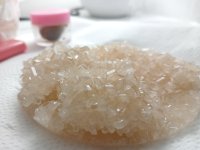WillD
Expert
- Joined
- Jul 19, 2021
- Messages
- 810
- Reaction score
- 1,119
- Points
- 93
Synthesis of 1,3-benzodioxole:

1. Catechol (100 g), potassium carbonate (200 g) and dimethylformamide (1000 ml) were added to a 3L three-neck round bottom flask fitted with a condenser, a dropping funnel and a thermometer.
2. The reaction was heated to 35 *C and dichloromethane (120 ml) was added dropwise.
3. The mixture was then heated at 110–120 *C for five hours and then left to cool.
4. The solution was decanted and 1500 ml of water was added.
5. The aqueous phase was extracted with 3x250 ml of diethyl ether.
6. The organic layers were then combined and washed with 3x500ml of water.
7. The organic layer was dried over anhydrous sodium sulphate, decanted and the solvent was removed with a rotary evaporator to yield a light-brown oil. Yield: 77 g.
Synthesis of 3,4-methylenedioxypropiophenone:

1. 1,3-Benzodioxole (100 g), zinc(II) chloride (170 g) and dichloroethane (1000 ml) were added to a 2L two-neck round bottom flask fitted with a dropping funnel.
2. The resulting mixture was cooled in an ice bath.
3. Propionyl chloride (110 ml) was added to the mixture dropwise and the reaction was left to stir for 18 h.
4. The reaction was quenched with water and 500 ml of diethyl ether was added.
5. The aqueous layer was removed, and the organic layer was washed with 3x250 ml 5% sodium carbonate solution and 3x250 ml of brine.
6. The organic layer was then dried over anhydrous sodium sulphate, decanted and the solvent was removed using a rotary evaporator, producing a dark brown liquid. Yield: 100 g.
Synthesis of 5-bromo-3,4-methylenedioxypropiophenone:

1. 3,4-Methylenedioxypropiophenone (100 g), cupric bromide (150 g), potassium bromide (7 g) and 1000 ml of dichloroethane were added to a 3 L round bottom flask with a condenser.
2. The solution was heated under reflux for 24 h, and then quenched with dichloromethane.
3. The resulting mixture was filtered, and the solids were washed with 1000 ml of dichloromethane.
4. The organic solution was dried over sodium sulphate, decanted and the solvent removed using a rotary evaporator, producing a dark brown liquid. Yield: 130 g.
Synthesis of Methylone:

1. 5-Bromo-3,4-methylenedioxypropiophenone (100 g) and 1000 ml of tetrahydrofuran were added to a 3 L round bottom flask.
2. Aqueous methylamine (300 ml, 40%) was added dropwise to the solution over 30 min.
3. The solution was left to stir for 18 h and basified with 1000 ml of 20% NaOH solution.
4. The product was extracted with 3x500 ml ethyl acetate and washed with 3x500 ml water.
5. Decant the ethyl acetate solution into a dry beaker, chilled in an ice bath.
6. Add a 1:5 solution of conc. HCl:IPA dropwise with manual stirring to the chilled ether solution to pH > 4.
7. Chill in the ice bath or into a freezer.
8. Collect the crystals by vacuum filtration and let air dry. Yield: 75 g.
1. Catechol (100 g), potassium carbonate (200 g) and dimethylformamide (1000 ml) were added to a 3L three-neck round bottom flask fitted with a condenser, a dropping funnel and a thermometer.
2. The reaction was heated to 35 *C and dichloromethane (120 ml) was added dropwise.
3. The mixture was then heated at 110–120 *C for five hours and then left to cool.
4. The solution was decanted and 1500 ml of water was added.
5. The aqueous phase was extracted with 3x250 ml of diethyl ether.
6. The organic layers were then combined and washed with 3x500ml of water.
7. The organic layer was dried over anhydrous sodium sulphate, decanted and the solvent was removed with a rotary evaporator to yield a light-brown oil. Yield: 77 g.
Synthesis of 3,4-methylenedioxypropiophenone:
1. 1,3-Benzodioxole (100 g), zinc(II) chloride (170 g) and dichloroethane (1000 ml) were added to a 2L two-neck round bottom flask fitted with a dropping funnel.
2. The resulting mixture was cooled in an ice bath.
3. Propionyl chloride (110 ml) was added to the mixture dropwise and the reaction was left to stir for 18 h.
4. The reaction was quenched with water and 500 ml of diethyl ether was added.
5. The aqueous layer was removed, and the organic layer was washed with 3x250 ml 5% sodium carbonate solution and 3x250 ml of brine.
6. The organic layer was then dried over anhydrous sodium sulphate, decanted and the solvent was removed using a rotary evaporator, producing a dark brown liquid. Yield: 100 g.
Synthesis of 5-bromo-3,4-methylenedioxypropiophenone:
1. 3,4-Methylenedioxypropiophenone (100 g), cupric bromide (150 g), potassium bromide (7 g) and 1000 ml of dichloroethane were added to a 3 L round bottom flask with a condenser.
2. The solution was heated under reflux for 24 h, and then quenched with dichloromethane.
3. The resulting mixture was filtered, and the solids were washed with 1000 ml of dichloromethane.
4. The organic solution was dried over sodium sulphate, decanted and the solvent removed using a rotary evaporator, producing a dark brown liquid. Yield: 130 g.
Synthesis of Methylone:
1. 5-Bromo-3,4-methylenedioxypropiophenone (100 g) and 1000 ml of tetrahydrofuran were added to a 3 L round bottom flask.
2. Aqueous methylamine (300 ml, 40%) was added dropwise to the solution over 30 min.
3. The solution was left to stir for 18 h and basified with 1000 ml of 20% NaOH solution.
4. The product was extracted with 3x500 ml ethyl acetate and washed with 3x500 ml water.
5. Decant the ethyl acetate solution into a dry beaker, chilled in an ice bath.
6. Add a 1:5 solution of conc. HCl:IPA dropwise with manual stirring to the chilled ether solution to pH > 4.
7. Chill in the ice bath or into a freezer.
8. Collect the crystals by vacuum filtration and let air dry. Yield: 75 g.
Last edited by a moderator:


